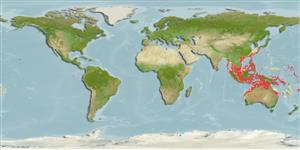Common names from other countries
Classification / Names / Names
Nomi Comuni | Sinonimi | Catalog of Fishes (gen., sp.) | ITIS | CoL | WoRMS
Environment: milieu / climate zone / depth range / distribution range
Ecologia
; distribuzione batimetrica 0 - 100 m (Ref. 101942). Tropical
Indo-West Pacific.
Length at first maturity / Size / Peso / Age
Maturity: Lm ? range ? - ? cm
Irregularly shaped. Hispid surface with steep-sided conical projections. Calcitic materials fills in grooves; ostia not visible. Oscula in the apex of the conules is hard to see underwater. Hard and corky texture, not easily compressible and hard to tear. Brown; dark conules than the rest of the body. Tightly packed spicules that criss-crosses each other, with some potruding to the surface.
Found in areas with coral rubbles and sandy substrate (Ref. 84985). Filter-feeder (Ref. 68823).
Life cycle and mating behavior
Maturità | Riproduzione | Deposizione | Uova | Fecundity | Larve
Members of the class Demospongiae are hermaphroditic. Life cycle: The zygote develops into parenchymella larva (free-swimming) before settling down on a substrate where it grows into a young sponge.
Hooper, J.N.A., J.A. Kennedy and R.W.M. van Soest. 2000. (Ref. 81108)
IUCN Red List Status (Ref. 130435)
CITES status (Ref. 108899)
Not Evaluated
Not Evaluated
Threat to humans
Harmless
Human uses
| FishSource |
Strumenti
Informazioni ulteriori
Age/SizeAccrescimentoLength-weightLength-lengthMorfologiaLarveAbbondanza
Fonti Internet
Estimates based on models
Preferred temperature
(Ref.
115969): 24.6 - 29, mean 28 (based on 1320 cells).
